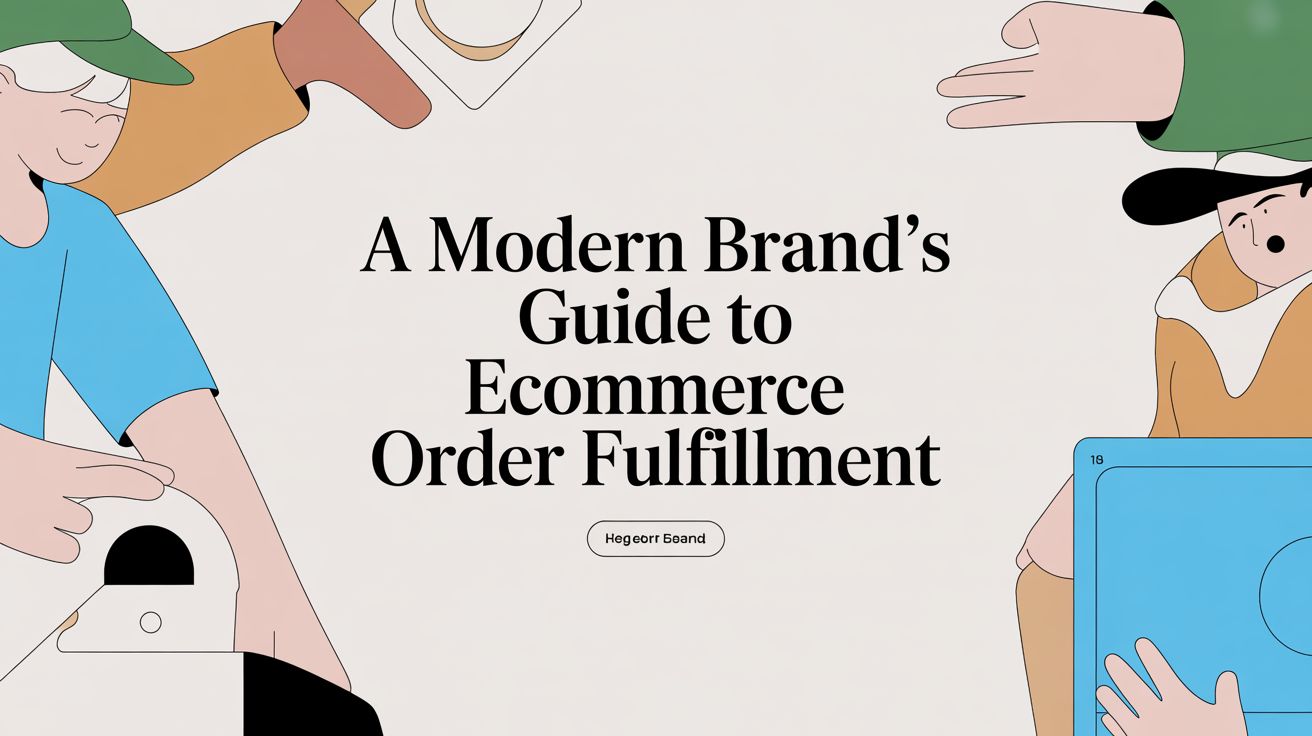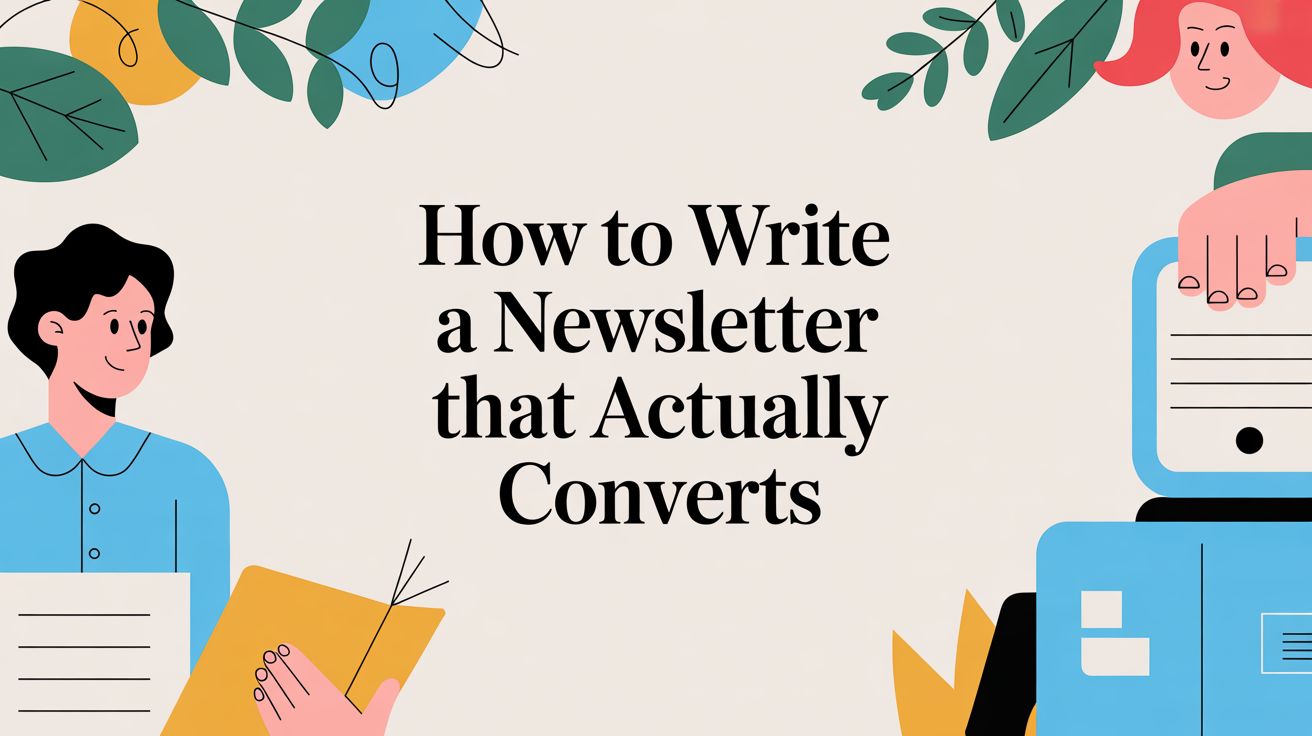
From Stockouts to Revenue: The Definitive Guide to Back in Stock Alerts
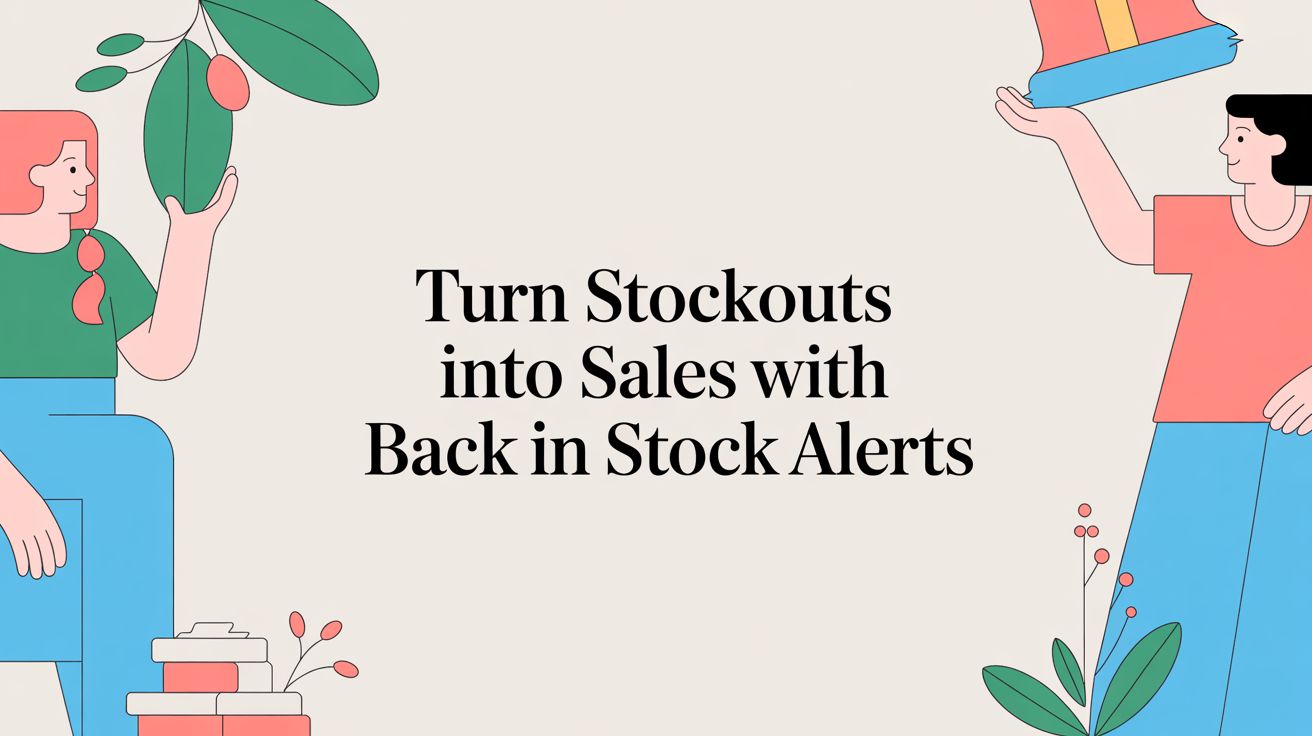
An out-of-stock product page isn’t a dead end. It’s a prime opportunity to recover lost sales and build anticipation. For many e-commerce brands, stockouts are a significant drain, costing 4-9% in annual revenue. But what if you could transform that challenge into a strategic advantage?
This guide reframes the "sold out" sign not as a frustrating problem, but as a sophisticated, psychology-driven engine for revenue recovery and enhanced customer loyalty.
The Hidden ROI in Out-of-Stock Products
A "Sold Out" sign often feels like a failure—a missed sale and a disappointed customer. This perspective misses a critical moment in the shopper's journey. Instead of a lost cause, an out-of-stock page can become a powerful tool for generating future revenue and deepening customer relationships.
The key is to turn that moment of friction into an opportunity for connection. Instead of letting a potential buyer bounce to a competitor's site, a simple "Notify Me When Available" button captures their high-intent interest at its absolute peak.
This isn’t just a convenient feature; it's a strategic application of consumer psychology.
Turning Disappointment into Anticipation
When a customer finds the perfect item only to see it's gone, their desire often intensifies. This is the scarcity principle, a core concept of behavioral economics, in action. When an item is less available, its perceived value increases dramatically.
By allowing customers to sign up for a back in stock alert, you are doing far more than collecting an email. You are nurturing a powerful psychological trigger: anticipation.
A waiting period doesn't have to be a negative experience. Handled correctly, it can transform a routine restock into an exciting event that drives immediate action the moment that notification hits their inbox.
That simple act of signing up creates a small but meaningful commitment. The customer has now mentally bookmarked your product and is personally invested in its return. This powerful effect, known as commitment and consistency, dramatically increases the odds they’ll return to complete the purchase. Explore more about the benefits of cultivating consumer anticipation in our detailed guide.
The Financial Impact of Smart Restock Alerts
The ROI of a well-executed back-in-stock strategy is substantial. Globally, stockouts lead to massive revenue loss for retailers. It's a universal pain point that directly impacts the bottom line.
However, the data shows a clear path to recovery: customers who sign up for and receive restock alerts convert at an impressive rate of 12% to 30%. To put that in perspective, the average e-commerce conversion rate hovers around 2.5%, and typical email campaigns convert at just 2-5%. These figures demonstrate how a psychologically-informed notification system can directly protect your bottom line and recover sales you would have otherwise lost for good.
The Psychology That Makes Back in Stock Alerts So Effective
A simple "back in stock" alert does more than inform a customer. It taps into powerful psychological triggers that compel immediate action. To move beyond basic notifications and create revenue-generating moments, you must understand the behavioral science at play.
At its core, a sold-out item immediately triggers the Scarcity Principle. It’s a foundational concept from behavioral economics: when something is less available, we perceive it as more valuable. A product that was one of many options suddenly becomes more desirable simply because it is unattainable. When it finally returns, that heightened sense of value persists, motivating a much faster purchase decision.
The Power of FOMO and Anticipation
This initial scarcity is the perfect catalyst for the Fear of Missing Out (FOMO). A customer who missed the product once is acutely aware that it could sell out again. This is not a manipulative tactic; it's a natural reaction to real supply-and-demand dynamics. The fact that it sold out before serves as powerful social proof, validating the customer's interest and adding legitimate pressure to act quickly.
The waiting period itself becomes a strategic asset. It builds Anticipation, turning a routine restock into an event people are actively awaiting. That anticipation creates an emotional investment, making the customer feel more connected to both the product and your brand.
This combination of psychological triggers primes the customer to buy. Unlike a cold marketing email, a back-in-stock alert arrives at a moment of peak interest for an item the shopper already decided they wanted. It’s a warm, welcome message that lands with a built-in reason to act now. You can dive deeper into these concepts in our complete guide to consumer psychology and why urgency causes action.
By leveraging these principles, you engineer a customer journey that transforms disappointment into desire. You aren’t just sending a notification; you’re resolving their FOMO and fulfilling their anticipation. That’s why these alerts generate such an impressive ROI and protect your profit margins from lost sales.
How to Design a High-Converting Notification Strategy
Turning a simple alert into a revenue-driving machine requires a deliberate strategy, not just activating a basic app. A high-impact back in stock notification system is a complete experience, thoughtfully designed from the moment a customer signs up to the final, satisfying click to buy. It starts with making the opt-in process itself seamless and compelling.
The sign-up form is your first point of conversion. It must be clean, prominent, and instantly communicate value. Avoid generic, disruptive pop-ups that merely capture emails. Instead, integrate an inline form directly into the product page so it feels like a natural part of the shopping experience. The same principles that create effective popups for Shopify apply here—it's about creating a smooth, intuitive user journey.
This visual illustrates how a simple and effective sign-up form can focus on a clear call-to-action to maximize opt-ins.
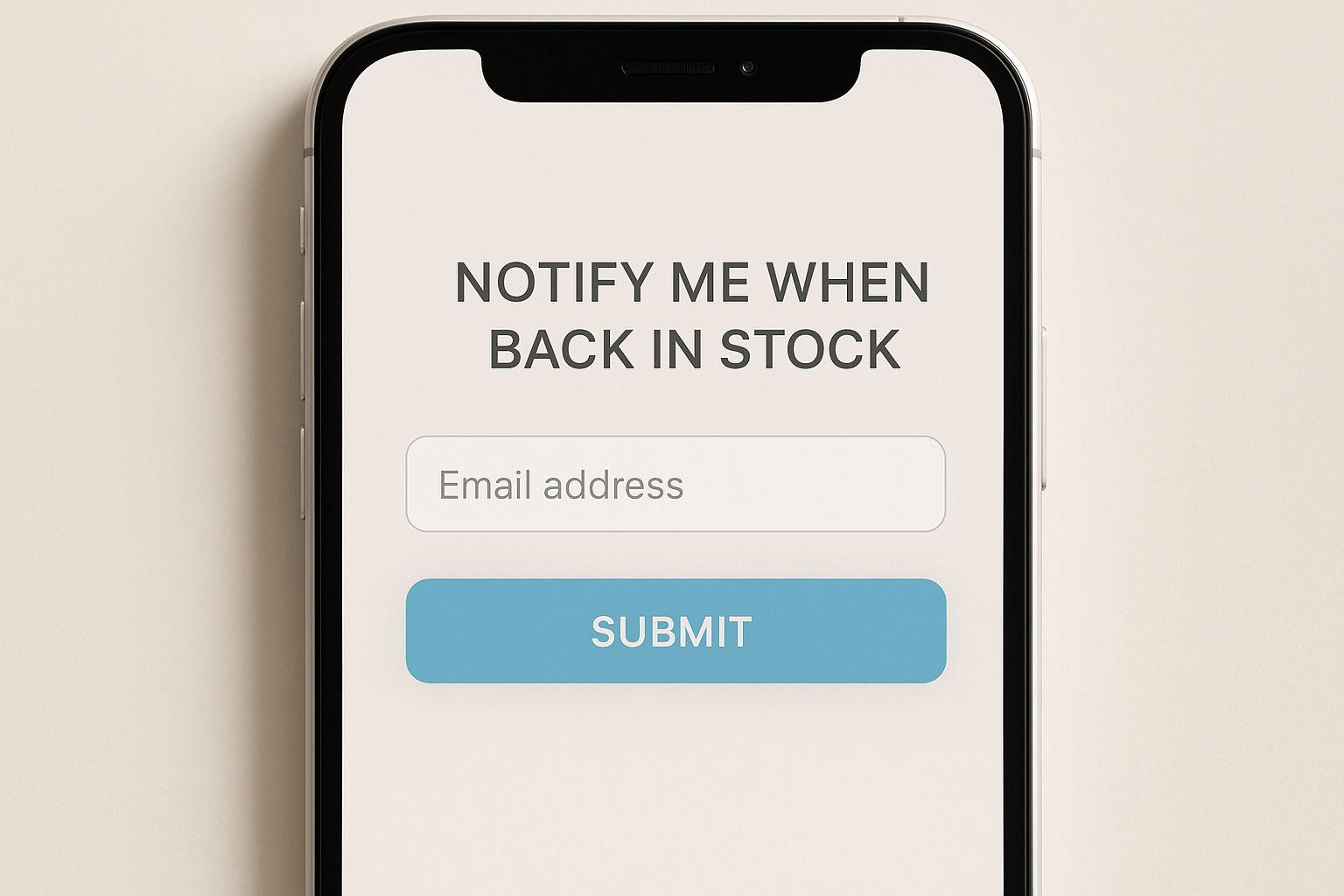
The key takeaway is simplicity. By reducing friction with a single input field and a clear button, you will significantly increase the number of shoppers joining your waitlist.
Crafting Compelling Notification Copy
Once they've signed up, the next step is to craft email and SMS messages that compel action. A bland message like "Your item is back" will be ignored. Your notification needs to reignite the initial desire that prompted the sign-up.
Here are actionable elements for a high-impact message:
- Urgent Subject Lines: Lead with scarcity. A subject line like, "It's Back (But Not for Long!) Your Favorite Sweater is Here" creates far more urgency than a generic announcement.
- Clear Calls-to-Action (CTAs): The button should be unmissable. Use action-oriented text that drives a click, like "Shop It Now Before It's Gone" or "Claim Yours Now."
- Visual Reinforcement: Always include a high-quality image of the product. It’s an instant visual cue that reminds the customer exactly what they were waiting for, re-establishing that emotional connection.
At its core, a back-in-stock alert is a highly effective form of retargeting in digital marketing. You're re-engaging shoppers who have explicitly signaled purchase intent, making these alerts one of the highest-ROI tools in your marketing arsenal.
Choosing the Right Channel
Deciding how to send your notification—email, SMS, or push—is just as important as the content. Each channel has distinct strengths and psychological impacts. Understanding where your customers are most likely to see and act on your message can dramatically influence conversion rates.
Let's compare the most common options.
Back in Stock Notification Channel Comparison
| Channel | Average Open/Engagement Rate | Conversion Potential | Best For |
|---|---|---|---|
| 20-30% | High | Rich content, including product images and recommendations. Great for reinforcing brand identity and cross-selling. | |
| SMS | 98% | Very High | Immediate, time-sensitive alerts where speed is critical. Perfect for creating a burst of urgent sales for high-demand items. |
| Push Notifications | 3-10% | Medium | Quick, simple reminders for highly engaged app users. Effective for driving immediate traffic back to your app. |
While SMS offers an unparalleled open rate, email provides more space for creative storytelling. The optimal strategy often involves a multi-channel approach, allowing customers to choose their preferred channel at sign-up.
Advanced Automation and Segmentation
For brands on platforms like Shopify, particularly Shopify Plus, the real power is unlocked through automation and segmentation. This is how you evolve from basic alerts to sophisticated, revenue-generating campaigns. Instead of broadcasting to your entire waitlist simultaneously, consider a tiered rollout strategy.
By segmenting your waitlist, you can notify your most valuable customers—those with the highest lifetime value or average order value—a few hours before everyone else. This VIP treatment rewards loyalty, creates an exclusive experience, and drives immediate sales from your best buyers.
Integrations are critical here. By connecting your e-commerce platform with tools like Klaviyo or your preferred SMS provider, you can build automated workflows that trigger notifications the moment inventory is updated. This eliminates manual effort and ensures you capitalize on built-up anticipation without delay. You're not just restocking a product; you're launching a predictable and profitable sales event.
Using Sign-Up Data for Smarter Inventory Management
A sophisticated back-in-stock strategy delivers more than just recovered sales; it transforms your customer waitlist into a source of actionable business intelligence. This data provides a direct line into consumer demand, allowing you to shift from reactive restocking to proactive, data-driven inventory planning.
Viewed this way, a simple sign-up list becomes a powerful strategic asset. By tracking which out-of-stock items attract the most sign-ups, you get a quantified, real-time picture of your most desired products. This isn't just feedback; it's a demand forecast that can shape your merchandising strategy and protect your bottom line.
From Waitlist to Business Intelligence
Think of each notification sign-up as a vote. A product that accumulates 500 sign-ups is sending a much stronger demand signal than one with only 20. This is data you can use immediately to optimize operations and drive revenue.
Here’s how to translate that data into smarter business decisions:
- Prioritize Purchasing: Allocate your inventory budget to restock products with the highest proven demand first. This ensures your capital is invested in items guaranteed to sell quickly, improving cash flow.
- Refine Order Quantities: Use waitlist data to place more accurate purchase orders. If a product consistently builds a large waitlist, that’s your evidence to increase the next order quantity and prevent future stockouts.
- Inform Product Development: Is a specific color, size, or style consistently selling out first and gathering the most sign-ups? Use that intelligence to guide the development of new products for which you already have a validated, built-in audience.
Protecting Profit Margins and Managing Risk
Poor inventory management is a direct threat to profitability. It creates operational headaches and erodes margins through overstocking, markdowns, and costly stockouts. These supply chain challenges have significant financial consequences, as seen across industries. You can explore more about these market dynamics from Trading Economics.
By leveraging back-in-stock sign-up data, you transition from relying on historical sales trends to using real-time, forward-looking demand signals. This minimizes the risk of ordering too much of a slow-moving item and ensures you have enough of your proven winners.
This data-driven approach enables a leaner, more efficient inventory model. You protect profit margins by reducing the need for deep discounts to clear excess stock.
Ultimately, your back-in-stock system becomes more than a notification tool—it’s a critical engine for sustainable, profitable growth, turning customer interest into a reliable business roadmap.
Turning a Restock Into a Revenue Event
A basic "back in stock" email is functional. It gets the job done. But simply getting the job done leaves significant revenue on the table. To truly maximize impact, you must elevate that notification into a high-urgency sales event by layering in proven psychological triggers.
This is the difference between a passive “It’s back” message and a compelling, psychologically-tuned moment that drives a surge of immediate sales. You're not just restocking a product; you're launching an anticipated event. This approach moves beyond slapping a generic countdown timer on an email; it’s about grounding urgency in the authentic dynamics of supply and demand.
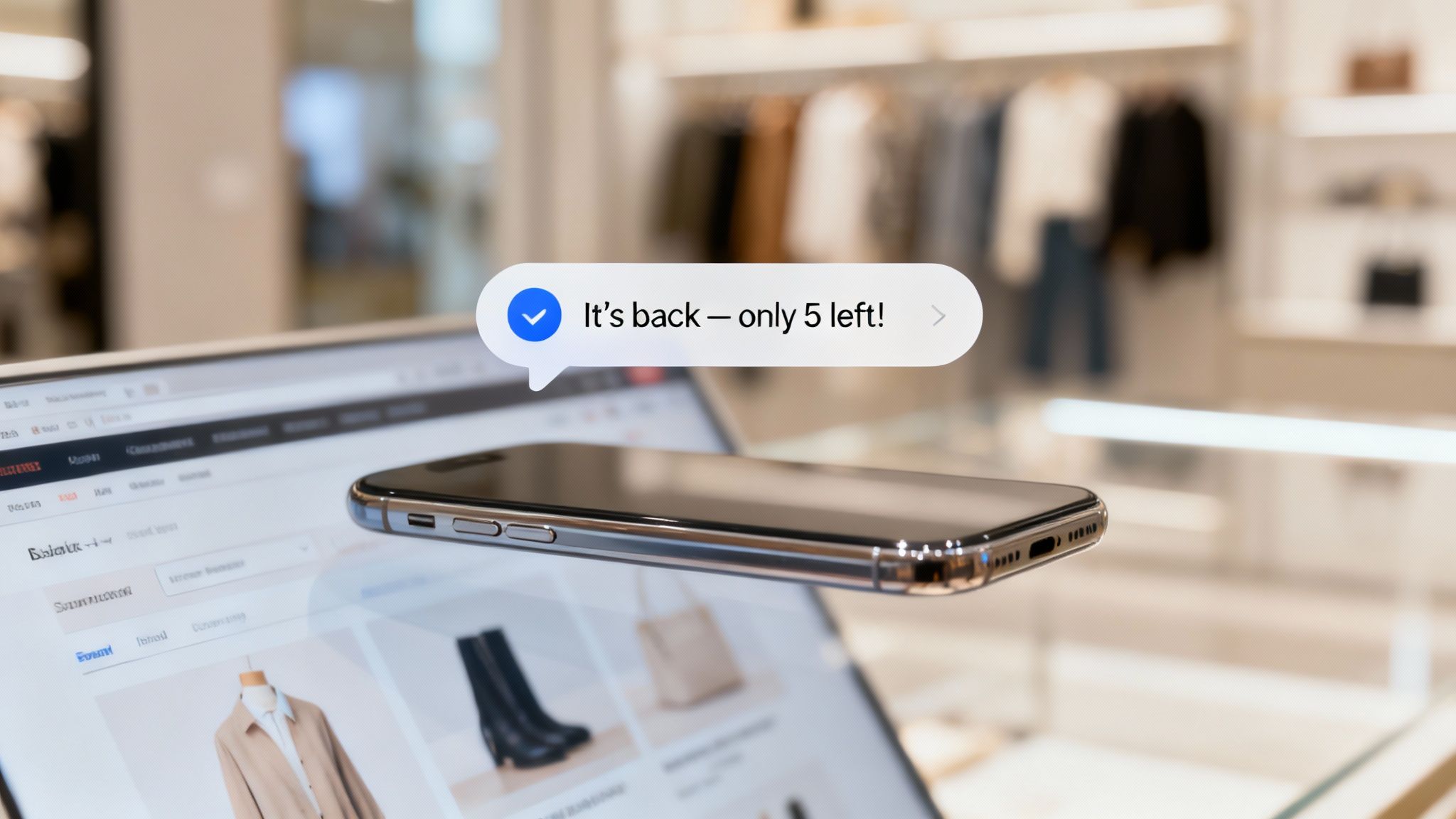
You are shifting from manufactured hype to authentic scarcity, and that distinction is critical for building trust and driving conversions.
Beyond Basic Timers: The Science of Layered Urgency
So, how do you create that impact? It's about combining several behavioral triggers into a single, cohesive message. Each layer reinforces the customer’s motivation to act now, converting interest into a completed purchase. This is where sophisticated marketing platforms like Quikly differentiate from simple email capture pop-ups, which primarily build lists rather than drive immediate revenue.
Here are the key psychological layers to integrate:
- Social Proof: Signal that demand is high. A message like, "You and 200 others are being notified," instantly validates their interest. It shows the product is popular and implies that competition to purchase will be fierce.
- Real-Time Scarcity: Don't just say stock is limited—show it. A dynamic stock counter that updates in real-time ("Only 15 left!") provides a tangible reason to stop deliberating and start buying. As that number drops, FOMO intensifies.
- Exclusivity: Make your waitlist feel like a VIP club. Offer early access to loyal customers or segment your list to give your best shoppers a head start. This rewards loyalty and adds a layer of privilege to the event.
This multi-layered strategy creates a powerful psychological cocktail that a basic, static alert simply cannot match.
Automation for Enterprise-Level Impact
For enterprise brands, especially those on Shopify Plus, managing these dynamic events manually is impossible. This is where sophisticated automation becomes a competitive advantage. Platforms like Quikly allow you to build complex, trigger-based "Moments" that run autonomously, integrating directly with your inventory systems and CRM tools like Klaviyo.
An advanced back-in-stock system isn’t just a notification tool; it’s an automated revenue-generation engine. It intelligently segments audiences, deploys layered urgency triggers, and executes flawlessly without manual oversight.
This level of automation ensures every restock is maximized for its full sales potential, protecting profit margins and increasing inventory velocity. The value extends beyond retail metrics; it’s a fundamental signal of operational health. This concept is mirrored in financial markets, where a company’s ability to manage inventory and meet demand directly impacts investor confidence. You can learn more about how supply dynamics impact market performance.
By automating your urgency marketing, you’re not just sending emails—you’re building a more resilient and profitable operation.
Your Top Questions About Back in Stock Alerts, Answered
When implementing a back in stock strategy, several key questions about performance, channels, and timing invariably arise. Nailing these details is what separates a passive waitlist from a high-performance revenue driver.
Let’s address the most common questions e-commerce managers have when optimizing their notification systems.
What Is a Good Conversion Rate for Back in Stock Notifications?
This is the critical benchmark. While performance varies by industry and product demand, a well-executed back in stock campaign should convert between 12% and 30% of sign-ups.
Consider the context: the average e-commerce website conversion rate is around 2.5%, and typical email campaigns are fortunate to achieve 2-5%. The significant increase with back in stock alerts is due to targeting shoppers with established, high purchase intent. They have already identified what they want; your notification is simply the catalyst they have been waiting for.
Should I Use Email or SMS for Back in Stock Alerts?
The most effective strategy is to offer both and let the customer choose. Each channel serves a different psychological function, and providing choice at the point of sign-up is the smartest approach.
- SMS Alerts: With open rates exceeding 90%, text messages are unparalleled for driving immediate action. They feel urgent and personal, making them perfect for high-demand items expected to sell out quickly.
- Email Alerts: Email allows for richer storytelling. You can use high-quality imagery, reinforce your brand voice, and even suggest complementary products. It transforms a simple alert into a more comprehensive marketing touchpoint.
Platforms that integrate with tools like Klaviyo can automate these multi-channel flows, ensuring you reach customers on their preferred channel without adding manual work for your team.
How Soon Should I Send a Notification After a Product Is Restocked?
Immediately. The moment your inventory is updated and the product is available for purchase, notifications must be sent. Any delay erodes the built-up anticipation.
You are capitalizing on a customer's peak excitement. If you wait, that excitement fades, and they may seek an alternative elsewhere. With the average cart abandonment rate near 70%, speed and relevance are paramount.
The goal is to close the gap between the customer's peak interest and their ability to purchase. Automating this process is non-negotiable for any serious e-commerce brand, as it ensures you capitalize on that excitement before the item sells out again or the customer's attention shifts.
This immediacy is what transforms a routine inventory update into a significant sales event.
Ready to transform your out-of-stock pages into a powerful revenue engine? Quikly helps you build psychologically-driven urgency campaigns that go beyond basic alerts. Discover how to turn anticipation into sales today.

The Quikly Content Team brings together urgency marketing experts, consumer psychologists, and data analysts who've helped power promotional campaigns since 2012. Drawing from our platform's 70M+ consumer interactions and thousands of successful campaigns, we share evidence-based insights that help brands create promotions that convert.
